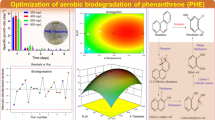Abstract
The mechanism of phenanthrene transfer to the bacteria during biodegradation by aPseudomonas strain was investigated using a sensitive respirometric technique (Sapromat equipment) allowing the quasi-continuous acquisition of data on oxygen consumption. Several systems of phenanthrene supply, crystalline solid and solutions in non-water-miscible solvents (silicone oil and 2,2,4,4,6,8,8-heptamethylnonane) were studied. In all cases, analysis of the kinetics of oxygen consumption demonstrated an initial phase of exponential growth with the same specific growth rate. In order to analyze the second phase of growth and phenanthrene degradation, a study of the kinetics of phenanthrene transfer to the aqueous phase was conducted by direct experimentation, with the crystal and silicone oil systems, in abiotic conditions. The data allowed the validation of a model based on phase-transfer laws, describing the variations, with substrate concentrations, of rates of phenanthrene transfer to the aqueous phase. Analysis of the biodegradation curves then showed that exponential growth ended in all cases when the rates of phenanthrene consumption reached the maximal transfer rates. Thereafter, the biodegradation rates closely obeyed, for all systems, the transfer rate values given by the model. These results unambiguously demonstrated that, in the present case, phenanthrene biodegradation required prior transfer to the aqueous phase. With the silicone oil system, which allowed high transfer and biodegradation rates, phenanthrene was directed towards higher metabolite production and lower mineralization, as shown by oxygen consumption and carbon balance determinations.
Similar content being viewed by others
References
Boldrin B, Tiehm A, Fritzsche C (1993) Degradation of phenanthrene, fluorene, fluoranthene, and pyrene by aMycobacterium sp. Appl Environ Microbiol 59:1927–1930
Bouchez M, Blanchet D, Vandecasteele JP (1995) Degradation of polycyclic aromatic hydrocarbons by pure strains and by defined strains associations: inhibition phenomena and cometabolism. Appl Microbiol Biotechnol (in press)
Cerniglia CE (1992) Biodegradation of polycyclic aromatic hydrocarbons. Biodegradation 3:351–368
Davis WW, Krohl ME, Clower GHA (1942) Solubilities of carcinogenic and related hydrocarbons in water. J Am Chem Soc 64:108–110
Dunn IJ (1968) An interfacial kinetics model for hydrocarbon oxidation. Biotechnol Bioeng 10:891–894
Efroymson RA, Alexander M (1994) Role of partitioning in biodegradation of phenanthrene dissolved in nonaqueous-phase liquids. Environ Sci Technol 28:1172–1179
Evans WC, Fernley HN, Griffiths E (1965) Oxidative metabolism of phenanthrene and anthracene by soil pseudomonads. The ring fission mechanism. Biochem J 95:819–831
Guerin WF, Jones GE (1988) Mineralization of phenanthrene by aMycobacterium sp. Appl Environ Microbiol 54:937–944
Herbert D, Phipps PJ, Strange RE (1971) Chemical analysis of microbial cells. In: Norris JR, Ribbons DW (eds) Methods in microbiology, vol 5B. Academic Press, London, pp 209–344
Kiyohara H, Nagao K (1978) The catabolism of phenanthrene and naphthalene by bacteria. J Gen Microbiol 105:69–75
Lane WF (1992) Estimating the equilibrium aqueous concentrations of polynuclear aromatic hydrocarbons in complex mixtures. Environ Sci Technol 26:983–990
Luthy RG, Dzombak DA, Peters CA, Roy SB, Ramaswami A, Nakles DV, Nott BR (1994) Remediating tar-contaminated soils at manufactured gas plant sites. Environ Sci Technol 28:266–276
May WE, Wasik SP, Freeman DH (1978) Determination of the solubility behavior of some polycyclic aromatic hydrocarbons in water. Anal Chem 50:997–1000
Ortega-Calvo JJ, Alexander M (1994) Roles of bacterial attachment and spontaneous partitioning in the biodegradation of naphthalene initially present in nonaqueous-phase liquids. Appl Environ Microbiol 60:2643–2646
Perry RH, Chilton CH, Kirkpatrick SD (eds) (1963) Chemical engineers′ handbook. McGraw-Hill, New York
Stucki G, Alexander M (1987) Role of dissolution rate and solubility in biodegradation of aromatic compounds. Appl Environ Microbiol 53:292–297
Thomas JM, Yordy JR, Amador JA, Alexander M (1986) Rate of dissolution and biodegradation of water-insoluble organic compounds. Appl Environ Microbiol 52:290–296
Volkering F, Breure AM, Sterkenburg A, Andel JG van (1991) Microbial degradation of polycyclic aromatic hydrocarbons: effect of substrate availability on bacterial growth kinetics. In: Verachtert H, Verstraete W (eds) International symposium. Environmental biotechnology. Part II. Royal Flemish Society of Engineers, pp 683–686
Volkering F, Breure AM, Sterkenburg A, Andel JG van (1992) Microbial degradation of polycyclic aromatic hydrocarbons: effect of substrate availability on bacterial growth kinetics. Appl Microbiol Biotechnol 36:548–552
Volkering F, Breure AM, Andel JG van (1993) Effect of microorganisms on the bioavailability and biodegradation of crystalline naphthalene. Appl Microbiol Biotechnol 40:535–540
Weissenfels WD, Beyer M, Klein J (1990) Degradation of phenanthrene, fluorene and fluoranthene by pure bacterial cultures. Appl Microbiol Biotechnol 32:479–484
Wodzinski RS, Bertolini D (1972) Physical state in which naphthalene and bibenzyl are utilized by bacteria. Appl Microbiol 23:1077–1081
Wodzinski RS, Coyle JE (1974) Physical state of phenanthrene for utilization by bacteria. Appl Microbiol 27:1081–1084
Wodzinski RS, Johnson MJ (1968) Yields of bacterial cells from hydrocarbons. Appl Microbiol 16:1886–1891
Wodzinski RS, Larocca D (1977) Bacterial growth kinetics on diphenylmethane and naphthalene-heptamethylnonane mixtures. Appl Environ Microbiol 33:660–665
Author information
Authors and Affiliations
Rights and permissions
About this article
Cite this article
Bouchez, M., Blanchet, D. & Vandecasteele, J.P. Substrate availability in phenanthrene biodegradation: Transfer mechanism and influence on metabolism. Appl Microbiol Biotechnol 43, 952–960 (1995). https://doi.org/10.1007/BF02431933
Received:
Accepted:
Issue Date:
DOI: https://doi.org/10.1007/BF02431933




